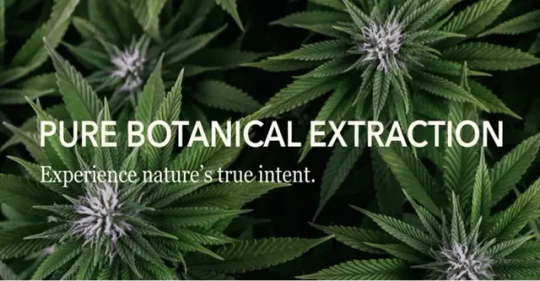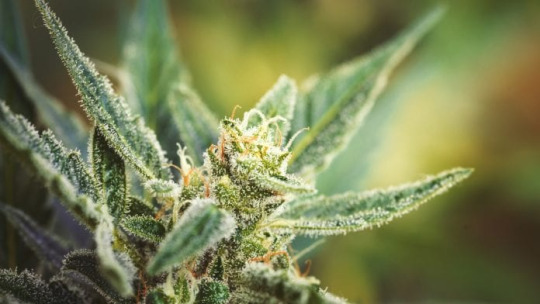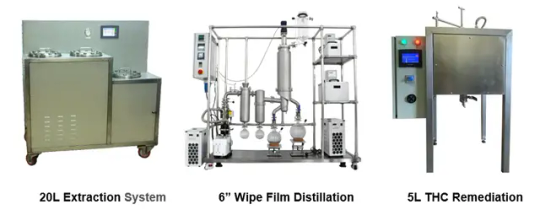PURE5™ is the most innovative cannabis & hemp processing company. With our superior extraction equipment and unique approach to extracting botanicals with minimal degradation to the natural constituents, we have set a new level of standards in the cannabis industry.
Don't wanna be here? Send us removal request.
Text
How Used Cannabis Extraction Equipment Can Enhance Your Extraction Operation

In the cannabis industry, the process of extracting valuable compounds like THC, CBD, and terpenes from raw plant material is critical to producing high-quality oils, tinctures, and concentrates. As technology advances and market competition increases, businesses are searching for more cost-effective and flexible solutions to optimize their production. One increasingly popular and practical approach is the use of Used Cannabis Extraction Equipment—a choice that blends operational efficiency with economic and environmental benefits.
Used equipment, when carefully sourced, offers many of the same advantages as new systems, but with significantly reduced capital investment. Let’s explore the major reasons why second-hand extraction systems are gaining traction in cannabis oil production:
1. Cost Savings Without Sacrificing Quality
New extraction systems, especially large-scale or high-end units, can be prohibitively expensive for smaller businesses or startups. Purchasing pre-owned equipment allows producers to access sophisticated technology at a lower cost. In many cases, this means gaining capabilities such as higher throughput, better solvent recovery, or more efficient temperature control without exceeding budget constraints. This is especially advantageous for companies entering new product markets, testing new formulations, or expanding capacity.
2. Faster Scaling and Deployment
Lead times for new extraction machines can range from several weeks to even months due to high demand and custom build requirements. In contrast, Used Cannabis Extraction Equipment is typically available for immediate shipment and installation. This significantly shortens the timeline for scaling operations or upgrading outdated systems, enabling businesses to respond quickly to market changes and customer demand.
3. Sustainability and Eco-Conscious Practices
The cannabis industry is becoming increasingly aware of its environmental footprint. Reusing extraction machinery contributes to a more circular economy by reducing waste and conserving resources required to manufacture new equipment. Companies can reduce their environmental impact while aligning with consumer values that increasingly favor green and responsible brands.
4. Test and Explore New Methods
For producers interested in experimenting with different extraction techniques—such as ethanol, hydrocarbon, CO₂, or solventless—used systems offer a less risky investment route. Businesses can trial a method on used equipment to evaluate its performance and feasibility before committing to a full-scale production setup. This agility supports innovation while minimizing financial exposure.
5. Availability of Trusted Brands and Models
The second-hand equipment market often includes reputable brands and industry-proven models. With careful research, buyers can find systems that are not only compatible with their production needs but also known for reliability and consistent output. Many units come from licensed facilities that are upgrading or closing, meaning they’ve already been used in compliant, regulated environments.
6. Potential for Customization and Retrofitting
Used extraction units can often be customized or upgraded with new components. Whether you need a better vacuum pump, enhanced temperature controls, or improved filtration, these modifications can often be made more affordably on used systems. This flexibility allows businesses to fine-tune their equipment to meet specific production goals.

Important Considerations Before Buying
While there are clear benefits, buying used equipment requires careful evaluation:
Check operational history: Maintenance logs, service reports, and previous usage can reveal potential issues or needed repairs.
Ensure regulatory compliance: Verify that the equipment meets local codes and safety standards.
Inspect for wear and damage: Ensure all seals, gaskets, and pressure components are intact and fully functional.
Consider professional installation and support: Even with used equipment, expert setup and calibration can maximize performance.
In summary, incorporating Used Cannabis Extraction Equipment into your cannabis oil production operation is a smart strategy for businesses focused on growth, innovation, and sustainability. When sourced thoughtfully, second-hand systems provide reliable performance and financial flexibility, empowering operators to stay competitive in a fast-moving industry.
0 notes
Text
What Equipment Is Used for Extracting CBD Oil from Cannabis?
Curious about how CBD oil is extracted from cannabis? The process involves specialized equipment designed to separate the valuable cannabinoids from plant material efficiently and safely.
Common methods include CO₂ extraction, ethanol extraction, and hydrocarbon extraction. CO₂ extraction is popular for its purity and precision, using pressurized carbon dioxide to pull CBD from the plant. Ethanol extraction, on the other hand, uses alcohol as a solvent, offering speed and simplicity. Hydrocarbon methods like butane or propane can yield high-potency extracts but require extra care due to flammability.

Each method requires specific tools—such as closed-loop extractors, rotary evaporators, and vacuum ovens—to handle the temperature, pressure, and safety demands of the process. The right setup ensures maximum yield and product quality, especially when scaling for commercial use.
Choosing the appropriate cannabis cbd oil extraction equipment depends on your budget, space, and desired output. Safety certifications, ease of use, and maintenance requirements are also key considerations when evaluating different systems.
Understanding the tools behind the scenes helps demystify the journey from raw plant to refined oil.
#cannabis#pure5extraction#cbdoilextraction#remediation services#cbd oil extraction#extraction-equipment
0 notes
Text
Hydrocarbon Extraction Equipment for Efficient Cannabis Oil Production
The cannabis industry has seen significant advancements in extraction technologies, with hydrocarbon extraction equipment emerging as a popular choice for producing high-quality concentrates. This method utilizes hydrocarbons like butane or propane to isolate desirable compounds from cannabis plant material, resulting in potent and flavorful extracts.
Understanding Hydrocarbon Extraction
Hydrocarbon extraction equipment works by passing liquefied hydrocarbons through cannabis biomass to dissolve cannabinoids and terpenes. The solution is then purged of solvents, leaving behind a pure, concentrated oil. This method is favored for its efficiency, scalability, and ability to preserve the plant’s natural profile.

Key Components of Hydrocarbon Extraction Systems
A typical hydrocarbon extraction system includes:
Extraction Vessel – Where the plant material is loaded and hydrocarbons are introduced.
Recovery Pump – Recaptures solvents for reuse, improving cost-efficiency.
Collection Pot – Gathers the extracted oil before further refinement.
Purging System – Removes residual solvents to meet safety standards.
Advantages of Hydrocarbon Extraction
High Yield – Extracts a larger percentage of cannabinoids compared to other methods.
Full-Spectrum Output – Retains terpenes and other beneficial compounds.
Fast Processing – Completes extraction cycles in minutes.
Scalability – Suitable for both small labs and large-scale operations.
Safety Considerations
Since hydrocarbons are flammable, proper safety measures are essential. Equipment should include:
Explosion-proof construction
Leak detection systems
Proper ventilation
Choosing the Right Hydrocarbon Extraction System
When selecting hydrocarbon extraction equipment, consider:
Material Compatibility – Ensure the system can handle your biomass type.
Automation Level – Automated systems reduce human error.
Regulatory Compliance – Meets industry safety and purity standards.
Hydrocarbon extraction remains a top choice for producers seeking high-quality cannabis concentrates. With the right equipment, operators can achieve consistent, potent extracts while maintaining safety and efficiency.
For premium extraction solutions, explore offerings from PURE5 Extraction.
#pure5extraction#cbdoilextraction#cannabis#remediation services#extraction equipment#cannabis extraction
0 notes
Text
How Much Does a CBD Extraction Machine Cost?
Investing in a CBD extraction machine cost can vary significantly based on factors like extraction method, capacity, and automation level. Prices can range from a few thousand dollars for small-scale units to several hundred thousand for industrial-grade systems.
The extraction method plays a crucial role in pricing. CO₂ extraction machines, known for their efficiency and purity, are typically more expensive than ethanol or hydrocarbon-based systems. Entry-level CO₂ extractors may start at around $30,000, while high-capacity models can exceed $500,000. Ethanol-based machines are generally more affordable, starting from $5,000 to $50,000, depending on size and features.

Other cost considerations include maintenance, energy consumption, and additional processing equipment like winterization and distillation units. Automation also impacts pricing, with fully automated systems requiring a higher investment but offering increased efficiency.
When evaluating the CBD extraction machine cost, it’s essential to consider long-term operational expenses alongside the initial purchase price. Choosing the right system depends on production needs, budget, and compliance with industry regulations. Proper research ensures a cost-effective and efficient extraction process.
#pure5extraction#cannabis#cbdoilextraction#remediation services#cannabis extraction#extraction equipment
0 notes
Text
The Art of Achieving the Most Efficient Extraction in Cannabis Processing
The cannabis industry has seen remarkable advancements in recent years, particularly in the realm of extraction technologies. As demand for high-quality cannabis products continues to grow, the focus has shifted toward achieving the most efficient extraction methods. This not only ensures the preservation of valuable compounds but also minimizes waste and maximizes output. In this blog, we’ll explore the key factors that contribute to efficient cannabis extraction and how the industry is evolving to meet these demands.
Cannabis extraction is the process of separating desired compounds, such as cannabinoids and terpenes, from the plant material. These compounds are the foundation of various cannabis products, including oils, tinctures, edibles, and concentrates. The goal of extraction is to isolate these elements in their purest form while maintaining their integrity and potency.
Efficiency in extraction is measured by several factors: the yield of the desired compounds, the quality of the final product, the time required for the process, and the amount of energy and resources consumed. Achieving the most efficient extraction requires a balance of these factors, ensuring that the process is both economically viable and environmentally sustainable.

Key Factors Influencing Extraction Efficiency
Choice of Solvent The solvent used in extraction plays a critical role in determining efficiency. Common solvents include ethanol, CO2, and hydrocarbons like butane or propane. Each solvent has its pros and cons. For instance, ethanol is cost-effective and versatile but may extract unwanted chlorophyll. CO2, on the other hand, is highly selective and produces a clean product but requires expensive equipment. The choice of solvent must align with the desired outcome and the scale of production.
Temperature and Pressure Control Maintaining optimal temperature and pressure during extraction is crucial. Excessive heat can degrade sensitive compounds like terpenes, while insufficient pressure may result in incomplete extraction. Advanced extraction systems now offer precise control over these parameters, ensuring that the process is both efficient and consistent.
Quality of Raw Material The starting material significantly impacts extraction efficiency. High-quality cannabis flower with a robust cannabinoid and terpene profile will yield better results compared to lower-grade material. Proper curing and storage of the plant material also play a role in preserving its potency and ensuring a smooth extraction process.
Equipment and Technology The extraction equipment used can make or break the efficiency of the process. Modern systems are designed to maximize yield while minimizing waste and energy consumption. Innovations such as closed-loop systems and automated controls have revolutionized the industry, making it easier to achieve the most efficient extraction possible.
Post-Processing Techniques Extraction is only the first step. Post-processing techniques like winterization, distillation, and filtration are essential for refining the extract and removing impurities. These steps ensure that the final product meets the highest standards of quality and purity.
The Role of Sustainability in Extraction Efficiency
As the cannabis industry grows, so does its environmental footprint. Sustainable practices are becoming increasingly important, not just for regulatory compliance but also for long-term viability. Efficient extraction methods that reduce energy consumption, minimize solvent use, and limit waste are at the forefront of this movement.
For example, some extraction systems now incorporate solvent recovery mechanisms, allowing for the reuse of solvents and reducing overall costs. Additionally, renewable energy sources like solar power are being integrated into extraction facilities to further enhance sustainability.

Innovations Driving Efficiency
The cannabis extraction industry is constantly evolving, with new technologies and methodologies emerging regularly. One such innovation is the use of cold extraction methods, which preserve heat-sensitive compounds and result in a higher-quality product. Another advancement is the development of solventless extraction techniques, such as rosin pressing, which eliminate the need for solvents altogether.
Automation is also playing a significant role in improving efficiency. Automated systems can monitor and adjust extraction parameters in real-time, ensuring consistent results and reducing the risk of human error. This not only improves the quality of the final product but also increases throughput, making large-scale production more feasible.
Challenges in Achieving Efficient Extraction
Despite the advancements, challenges remain. One of the biggest hurdles is the lack of standardized regulations across different regions. This can lead to inconsistencies in product quality and make it difficult for companies to implement best practices.
Another challenge is the high initial cost of advanced extraction equipment. While these systems offer long-term benefits, the upfront investment can be prohibitive for smaller operators. However, as the industry matures, it is expected that costs will decrease, making these technologies more accessible.
The Future of Cannabis Extraction
The future of cannabis extraction lies in continuous innovation and a commitment to sustainability. As consumer demand for high-quality, consistent products grows, so too will the need for efficient extraction methods. Companies that prioritize research and development, invest in cutting-edge technology, and adopt sustainable practices will be well-positioned to lead the industry.
Achieving the most efficient extraction in cannabis processing is a multifaceted endeavor that requires careful consideration of various factors. From the choice of solvent to the implementation of advanced technologies, every step plays a crucial role in determining the success of the extraction process. As the industry continues to evolve, the focus on efficiency and sustainability will remain paramount, driving innovation and shaping the future of cannabis extraction.
This blog is brought to you by PURE5 Extraction, a leader in innovative cannabis extraction solutions.
#pure5extraction#cbdoilextraction#extraction equipment#cannabis extraction#remediation services#cannabis
0 notes
Text
What Makes Better Ethanol Extraction the Key to Higher Quality Products?
Ethanol extraction has become one of the most reliable methods for producing high-quality concentrates in the cannabis industry. This process uses ethanol to separate cannabinoids and terpenes from plant material, resulting in a pure, potent extract. The key to superior results lies in refining the extraction process.
A well-controlled better ethanol extraction process can minimize the presence of undesirable compounds like chlorophyll, fats, and waxes, leading to a cleaner, more refined product. The temperature, ethanol concentration, and extraction duration all play critical roles in optimizing efficiency while preserving the integrity of cannabinoids and terpenes.

One significant advantage of ethanol extraction is its ability to scale for both small and large batches, making it accessible for producers of varying sizes. Additionally, ethanol is safe, cost-effective, and easy to remove from the final product, ensuring compliance with safety and regulatory standards.
Ultimately, achieving the highest possible quality from ethanol extraction involves paying attention to each step of the process, from selecting the right raw materials to fine-tuning the extraction parameters. For those looking to improve product consistency and potency, mastering ethanol extraction can significantly elevate the overall outcome.
#pure5 extraction#pure5#cannabis extraction equipment#maceration extraction#george stantchev#r134a extraction machine
0 notes
Text
Efficient Solutions for Natural Ingredient Processing
As the demand for natural and plant-based products continues to grow, the methods used to extract high-quality compounds from plants have advanced significantly. Modern techniques focus on precision, sustainability, and efficiency to preserve the purity of bioactive ingredients. Key factors in successful extraction include selecting the right raw materials, optimizing processing parameters, and maintaining strict quality control throughout the process.
Sophisticated machinery designed for extracting botanical compounds plays a pivotal role in achieving these objectives. These systems are engineered to handle a variety of plant materials, ensuring the active compounds remain intact during processing. By utilizing advanced technologies such as supercritical CO2 extraction, solvent extraction, or cold pressing, manufacturers can produce extracts that meet stringent purity and potency standards.

One of the most crucial aspects of this process is scalability, as equipment must accommodate both small-scale research applications and large-scale production demands. Botanical extraction equipment offers versatility to process diverse materials, from herbs and roots to flowers and seeds, making it an indispensable tool in industries like cosmetics, pharmaceuticals, and nutraceuticals.
Investing in efficient and sustainable systems ensures that businesses can meet growing consumer demands for natural, high-quality products while reducing their environmental impact.
0 notes
Text
Understanding Hydrocarbon Extraction Equipment
Hydrocarbon extraction equipment plays a crucial role in the oil and gas industry, enabling the efficient separation of hydrocarbons from raw materials. This process involves various technologies and methodologies designed to isolate valuable resources while minimizing environmental impact.
The extraction process typically begins with the collection of raw materials, such as crude oil or natural gas, from wells. Specialized equipment, including separators, compressors, and pumps, is utilized to facilitate the efficient extraction of hydrocarbons. Each component is designed to handle specific aspects of the extraction process, ensuring maximum yield and quality of the end product.

Advancements in hydrocarbon extraction technology have led to more sustainable practices. For example, innovative methods such as gas-to-liquids (GTL) and enhanced oil recovery (EOR) have emerged, allowing for the extraction of hydrocarbons that were previously considered inaccessible. These techniques not only improve extraction efficiency but also reduce greenhouse gas emissions, contributing to a more environmentally responsible approach in the industry.
Hydrocarbon extraction equipment is essential for optimizing the extraction process, enhancing resource recovery, and promoting sustainability in the oil and gas sector. Understanding the intricacies of this equipment is vital for professionals aiming to navigate the complexities of hydrocarbon production.
0 notes
Text
Cannabis Extraction: Understanding the Process and Methods
Cannabis extraction is the process of separating the desired compounds from the cannabis plant, particularly cannabinoids like THC and CBD, along with terpenes and flavonoids. This process is essential for producing a variety of cannabis products, such as oils, tinctures, edibles, and concentrates.
There are several methods used in extraction, each with unique benefits. One common technique is solvent-based extraction, which utilizes chemicals like ethanol, butane, or CO2 to dissolve and extract the plant’s compounds. CO2 extraction is often preferred due to its safety and ability to produce high-quality extracts without residual solvents.

Another popular method is solventless extraction, where heat, pressure, or mechanical agitation is used to extract cannabinoids without chemicals. Examples include rosin pressing or dry-sifting.
Each method of cannabis extraction has its pros and cons, depending on the desired end product. Solvent-based extractions generally yield higher purity and potency, while solventless methods offer a more natural, clean product.
The efficiency and quality of extraction play a crucial role in ensuring the final product delivers the expected therapeutic or recreational benefits, making it a cornerstone of the cannabis industry.
0 notes
Text
The Cost Benefits of Adopting Cheaper Extraction Techniques
In today's fast-paced world, the need for efficient and cost-effective extraction methods has never been more critical.

When it comes to extracting resources or materials, adopting safer, cheaper, and faster extraction techniques can significantly enhance productivity and profitability. These modern methods leverage advanced technology to streamline processes, reduce operational costs, and minimize environmental impact.
One of the primary benefits of safer cheaper faster extraction is the reduction in overall expenses. By employing innovative techniques and equipment, businesses can lower operational costs while achieving higher extraction rates. This efficiency not only maximizes returns on investment but also ensures a more sustainable approach to resource management. Moreover, advancements in extraction technology contribute to a safer working environment by minimizing risks associated with traditional methods.
Overall, the shift towards safer, cheaper, and faster extraction methods represents a positive change in various industries. Embracing these advancements allows for improved resource management, cost savings, and enhanced safety, paving the way for a more efficient and responsible approach to extraction.
0 notes
Text
Hemp and Cannabis Extraction Equipment
Hemp and cannabis extraction equipment plays a crucial role in producing high-quality extracts for various applications, including medicinal, recreational, and industrial products. The extraction process typically involves separating valuable cannabinoids, terpenes, and other compounds from the plant material. Essential equipment for this process includes extractors, separators, and filtration systems.

Advanced extraction equipment often includes features like precise temperature and pressure controls, automated systems, and safety mechanisms to ensure efficient and consistent results. As the hemp and cannabis extraction equipment industry continues to grow, advancements in extraction technology are driving improvements in the quality, safety, and efficiency of extracted products.
The most common extraction methods are solvent-based and solventless techniques. Solvent-based methods, such as CO2 extraction and ethanol extraction, use solvents to dissolve the desired compounds, which are then separated and purified. CO2 extraction is favored for its ability to produce pure and potent extracts without residual solvents, while ethanol extraction is praised for its efficiency and scalability.
Solventless extraction methods, such as rosin pressing and ice water hash extraction, use heat and pressure or ice water agitation to extract cannabinoids and terpenes without chemical solvents. These methods are popular for their simplicity and the ability to produce high-quality, full-spectrum extracts.
0 notes
Text
Unveiling the Essence: The Artistry of Cannabis Extraction
Cannabis extraction, an intricate process blending science with artistry, is pivotal in harnessing the plant's therapeutic potential. This method meticulously isolates cannabinoids and terpenes from the raw plant material to create concentrates, oils, and tinctures renowned for their medicinal and recreational benefits.

At its core, cannabis extraction employs various techniques such as solvent-based extraction, including hydrocarbon and ethanol methods, and solventless extraction like rosin pressing and dry sieving. Each technique carries its nuances, impacting the final product's potency, flavor profile, and purity.
Solvent-based methods utilize substances like butane or ethanol to dissolve cannabinoids and terpenes, separating them from the plant material. This approach yields potent extracts rich in cannabinoids, often favored for their versatility in product formulation.
Conversely, solventless extraction methods prioritize purity and flavor retention by avoiding chemical solvents. Rosin pressing, for instance, employs heat and pressure to squeeze resinous compounds from the plant, offering a solvent-free concentrate prized for its natural flavor and potency.
Moreover, advancements in extraction technology continue to refine the process, enhancing efficiency and product quality. Innovations like supercritical CO2 extraction enable precise control over extraction parameters, yielding consistent and high-quality extracts prized by discerning consumers.
In essence, cannabis extraction embodies a delicate balance of science and craftsmanship, unlocking the plant's therapeutic potential while catering to diverse consumer preferences and needs. As the industry evolves, mastering this art remains paramount in delivering premium cannabis products to enthusiasts worldwide.
#pure5extraction#cannabis#cbd oil extraction#cannabisextraction#cannabis cbd oil extraction equipment
0 notes
Text
Advancing Extraction: Cutting-Edge Botanical Extraction Equipment

Unlocking the full potential of botanical extracts requires precision and innovation in extraction methods. Botanical extraction equipment stands at the forefront of this revolution, offering unparalleled efficiency and purity in extracting valuable compounds from plants. These advanced machines employ techniques such as supercritical CO2 extraction, hydrocarbon extraction, and ethanol extraction to meticulously isolate desired compounds while preserving their integrity. With customizable parameters and state-of-the-art technology, these systems ensure optimal extraction yields while minimizing solvent residue. From cannabis to medicinal herbs, botanical extraction equipment empowers industries to harness nature's bounty with unparalleled precision, consistency, and purity, driving innovation and advancement in various fields.
0 notes
Text
Understanding Harmonic Distillation: A Revolutionary Process

Harmonic Distillation represents a breakthrough in chemical engineering, offering a sustainable and efficient method for separating complex mixtures. At its core, this process leverages the principles of resonance and frequency modulation to selectively isolate desired components from a mixture, such as essential oils from plants or chemicals from industrial solutions.
Unlike traditional distillation methods, Harmonic Distillation operates at lower temperatures and pressures, reducing energy consumption and preserving the integrity of sensitive compounds. By applying specific frequencies, it targets molecular bonds, facilitating their separation without the need for harsh solvents or excessive heat.
This innovative technique not only enhances product purity but also minimizes environmental impact, making it a promising solution for various industries, from pharmaceuticals to perfumery. Embracing Harmonic Distillation heralds a new era of sustainable extraction and purification processes, driving advancements towards a greener and more efficient future.
0 notes
Text
Fully Automated Oil Extraction

Pure5Extraction revolutionizes the oil industry with its cutting-edge technology in Fully Automated Oil Extraction. This innovative company employs state-of-the-art machinery and advanced robotics to streamline the oil extraction process, ensuring efficiency and precision at every step.
Pure5Extraction's fully automated systems not only enhance productivity but also guarantee a consistently high-quality output. By integrating artificial intelligence and robotics, the company minimizes human intervention, reducing the margin of error and increasing overall safety in oil extraction operations.
The technology employed by Pure5Extraction maximizes yield while minimizing waste, making the extraction process more sustainable and environmentally friendly. This commitment to eco-conscious practices positions Pure5Extraction as a leader in responsible and efficient oil extraction.
With a focus on research and development, Pure5Extraction continues to push the boundaries of what is possible in the oil industry. The company's dedication to innovation ensures that its fully automated extraction systems remain at the forefront of technological advancements, setting new standards for the entire oil extraction sector. As a result, Pure5Extraction stands as a symbol of progress, efficiency, and sustainability in the ever-evolving landscape of oil extraction.
#cannabisextraction#pure5extraction#cannabis#cannabis cbd oil extraction equipment#fully automated oil extraction#cbdoilextraction
0 notes
Text
Where Can I Learn More About Cannabis Extraction Techniques?

In recent years, the burgeoning interest in cannabis, particularly in its various forms and applications, has led to a surge in curiosity about extraction techniques. As more people explore the therapeutic potential of cannabinoids like CBD oil, understanding how these compounds are extracted from the cannabis plant becomes increasingly important. Whether you're a budding enthusiast or a seasoned professional looking to delve deeper into the world of cannabis extraction, there are numerous resources available to expand your knowledge.
One of the first places to turn to for information on cannabis extraction techniques is the internet. A plethora of online platforms offer comprehensive guides, articles, and videos that cover everything from basic extraction methods to advanced technologies. Websites dedicated to cannabis education, industry forums, and scientific publications provide valuable insights into the various approaches used to extract cannabinoids and other beneficial compounds from the plant.
For those seeking a more structured learning experience, educational institutions and training programs focused on cannabis studies offer courses specifically tailored to extraction techniques. These programs often combine theoretical knowledge with hands-on training, providing students with a solid foundation in the principles and practices of cannabis extraction. From introductory workshops to in-depth certificate programs, aspiring extractors can find opportunities to enhance their skills and expertise.
In addition to online resources and formal education, industry conferences and events serve as invaluable platforms for learning about the latest developments in cannabis extraction. These gatherings bring together experts, researchers, and professionals from across the globe to share insights, discuss innovations, and showcase cutting-edge equipment and technologies. Attending conferences and networking with peers not only expands your knowledge base but also fosters connections within the cannabis community.
Books and literature also play a vital role in deepening your understanding of cannabis extraction techniques. From comprehensive textbooks covering the science behind extraction processes to practical guides detailing equipment selection and operation, there's a wealth of information available in print. Building a library of authoritative texts allows you to access valuable reference materials whenever you need to refresh your knowledge or explore new concepts.
Moreover, collaborating with experienced professionals in the cannabis industry can provide valuable mentorship and practical insights into extraction techniques. Whether through internships, apprenticeships, or job shadowing opportunities, working alongside seasoned extractors offers a hands-on learning experience that complements formal education. By observing real-world operations and gaining firsthand experience with extraction equipment, you can gain invaluable skills and expertise.
Finally, companies specializing in cannabis extraction equipment and technologies often offer resources and support to educate customers and industry professionals. Manufacturers frequently host workshops, webinars, and training sessions to familiarize users with their products and demonstrate best practices for efficient extraction. Taking advantage of these resources not only helps you understand the capabilities of different equipment but also ensures safe and effective operation.
learning about cannabis extraction techniques involves exploring a diverse range of resources, from online platforms and educational programs to industry events and hands-on experience. By leveraging these resources effectively, you can gain a comprehensive understanding of the principles and practices underlying cannabinoid extraction. Whether you're interested in starting your own extraction business or simply expanding your knowledge for personal or professional growth, there are ample opportunities to learn and grow in this dynamic field.
#cannabis#pure5extraction#cbdoilextraction#hemp-cannabis-extraction#extraction-equipment#cannabisextraction
0 notes
Text
Hemp and Cannabis Extraction Equipment
Innovations in Hemp and Cannabis Extraction Equipment: Paving the Way for High-Quality Extracts

Introduction:
In recent years, the hemp and cannabis industries have witnessed a surge in popularity and acceptance, driven by the increasing recognition of their therapeutic and recreational benefits. As these industries continue to evolve, so does the demand for efficient and advanced extraction equipment that can yield high-quality extracts. This article delves into the cutting-edge technologies and innovations shaping the world of hemp and cannabis extraction equipment.
Supercritical CO2 Extraction:
One of the most widely used methods for extracting cannabinoids from hemp and cannabis is supercritical carbon dioxide (CO2) extraction. This process involves using CO2 in its supercritical state as a solvent to extract cannabinoids, terpenes, and other beneficial compounds from the plant material. Supercritical CO2 extraction offers a clean and precise method, ensuring that the final product is free from residual solvents and contaminants.
Ethanol Extraction:
Ethanol extraction is another popular method, utilizing high-proof ethanol to dissolve and extract cannabinoids from the plant material. This method is known for its efficiency in extracting a wide range of compounds, including cannabinoids, terpenes, and flavonoids. Ethanol extraction is also valued for its scalability and cost-effectiveness.
Hydrocarbon Extraction:
Hydrocarbon extraction involves the use of hydrocarbons such as butane or propane to extract cannabinoids from the plant material. This method is highly efficient, extracting a broad spectrum of compounds and preserving the plant's natural profile. However, it requires careful attention to safety protocols due to the flammable nature of hydrocarbons.
Rotary Evaporators and Distillation:
After the initial extraction, rotary evaporators and distillation systems come into play to further refine the extract. Rotary evaporators remove solvents from the extract, while distillation separates different components based on their boiling points. These processes help in achieving a purer and more concentrated final product.
Closed-Loop Extraction Systems:
Closed-loop extraction systems are designed to maximize the efficiency and safety of the extraction process. These systems are sealed, preventing any leakage of solvents or gases into the environment. Closed-loop systems are essential for compliance with safety regulations and ensuring the overall quality of the extracted products.
Innovative Extraction Technologies:
The constant pursuit of improvement in extraction technologies has led to the development of innovative methods. Ultrasonic extraction, for example, uses high-frequency sound waves to break down plant cell walls and facilitate the extraction process. This method is known for its speed and ability to extract a wide range of compounds.
Automation and Control Systems:
Modern extraction equipment is often equipped with advanced automation and control systems. These systems allow operators to precisely control parameters such as temperature, pressure, and flow rates, ensuring a consistent and reproducible extraction process. Automation also contributes to increased efficiency and reduced labor requirements.
The Importance of Quality Control:
Ensuring the quality of hemp and cannabis extracts is paramount, and extraction equipment plays a crucial role in this process. Advanced analytical technologies, such as high-performance liquid chromatography (HPLC) and gas chromatography-mass spectrometry (GC-MS), are employed to analyze and quantify the compounds present in the extracts. This rigorous quality control helps meet regulatory standards and consumer expectations.
Scaling Up Production:
As the demand for hemp and cannabis products continues to grow, extraction facilities are scaling up their production capacities. This requires extraction equipment that is not only efficient on a small scale but also capable of handling large volumes of plant material without compromising the quality of the extracts.
Conclusion:
In conclusion, the advancements in hemp and cannabis extraction equipment have significantly contributed to the production of high-quality extracts with precise cannabinoid profiles. From supercritical CO2 extraction to innovative technologies like ultrasonic extraction, the industry continues to evolve. As we look towards the future, companies like Pure5Extraction stand at the forefront, providing state-of-the-art equipment to meet the demands of a rapidly expanding market.
Pure5Extraction: Pioneering Excellence in Hemp and Cannabis Extraction Equipment.
0 notes